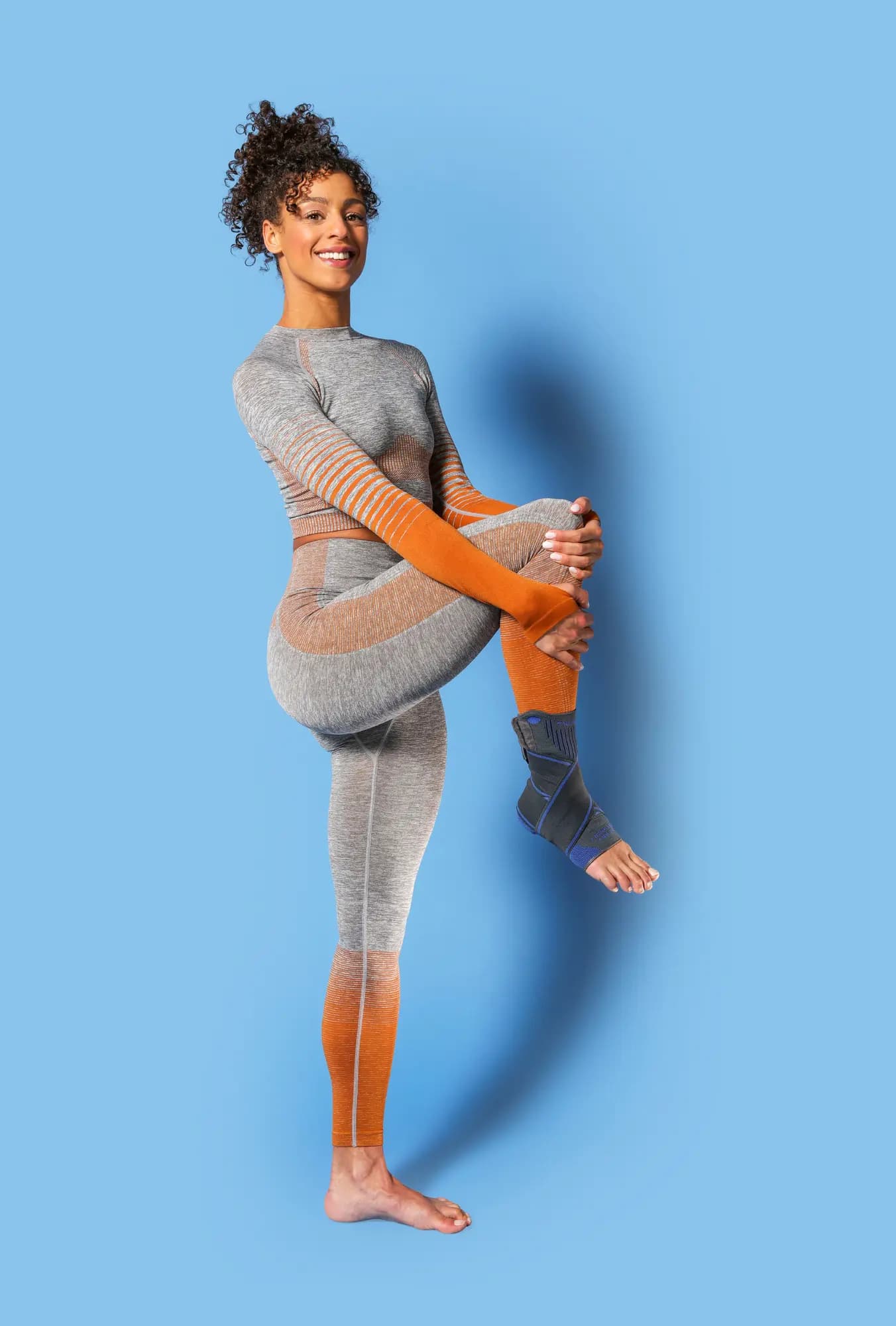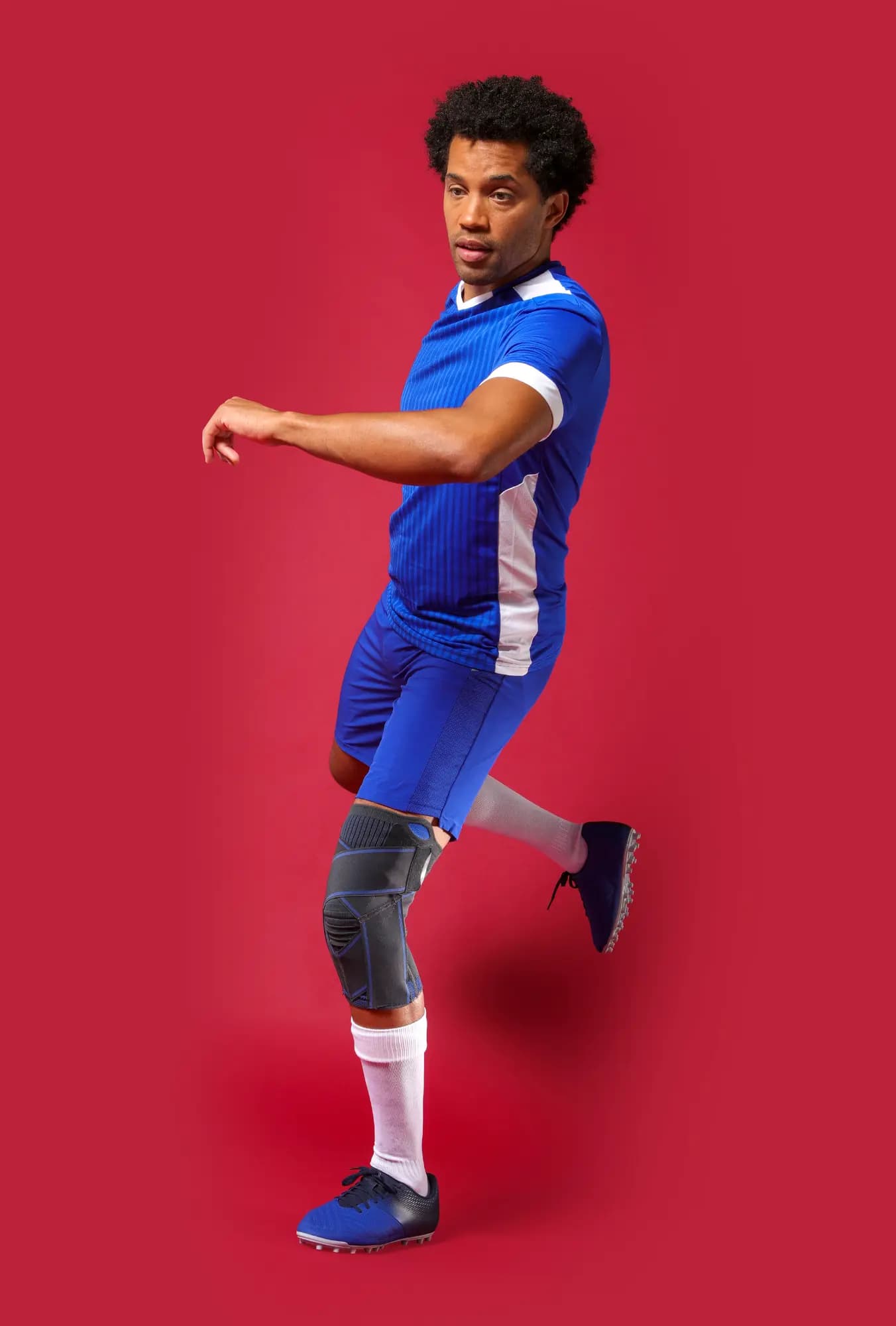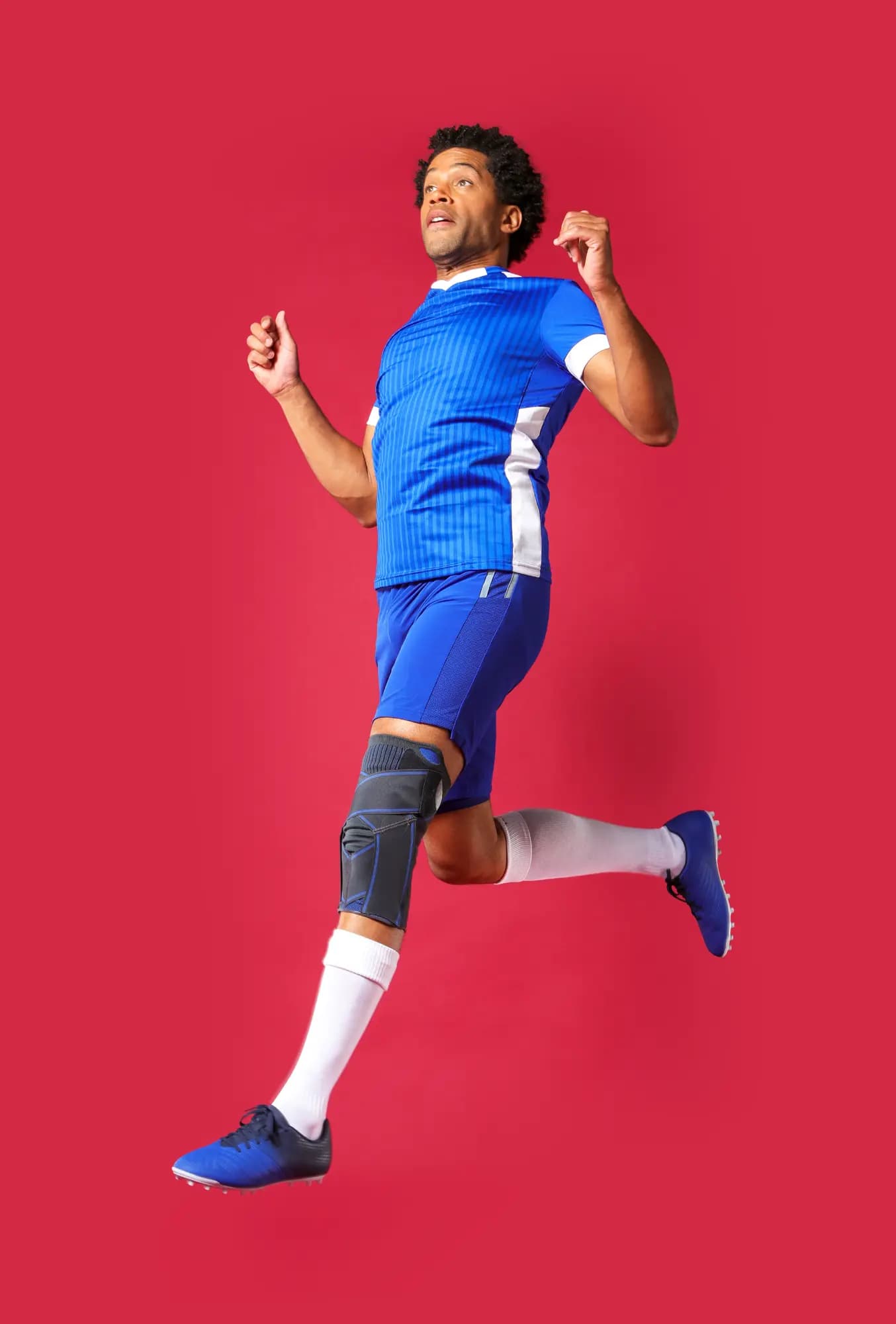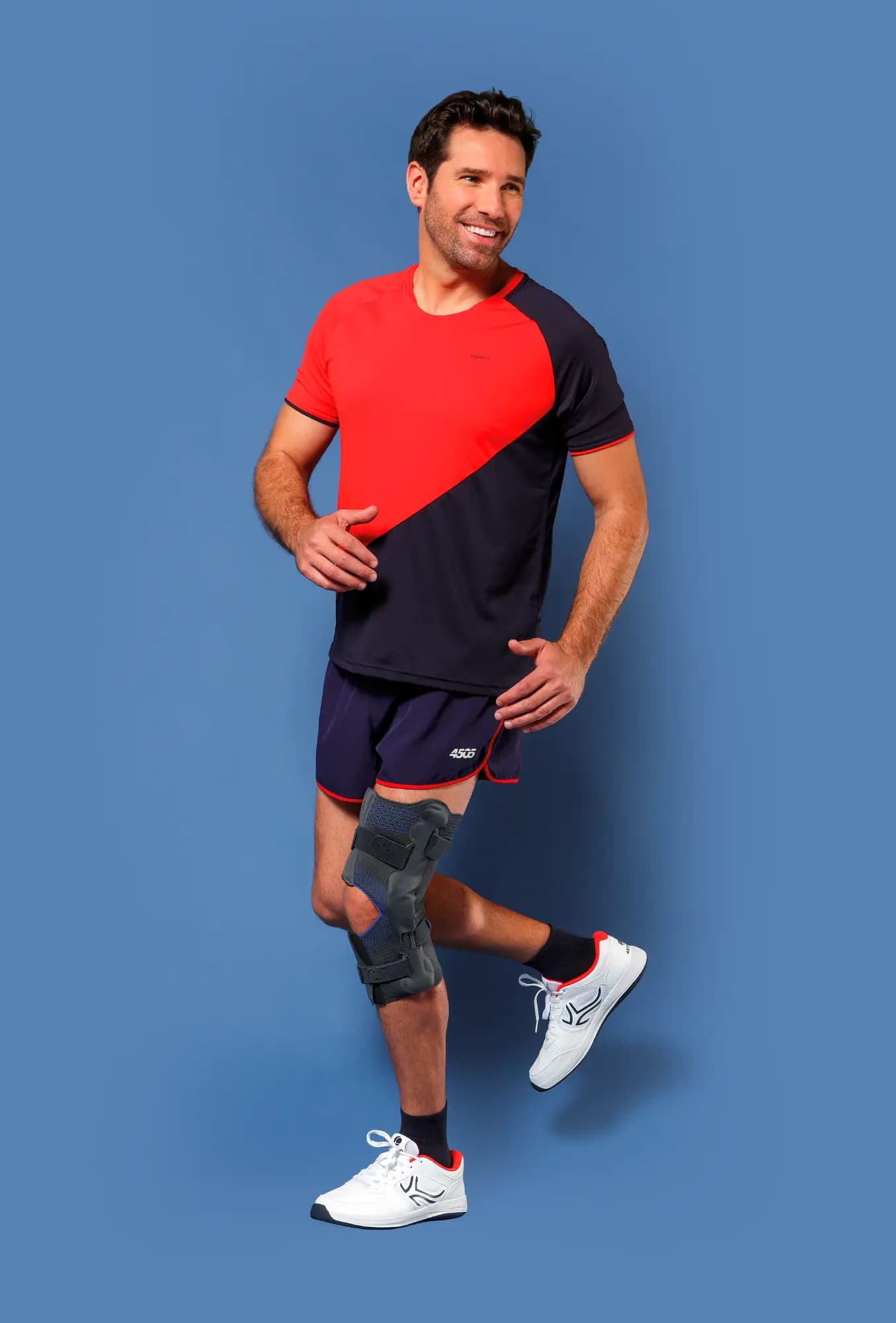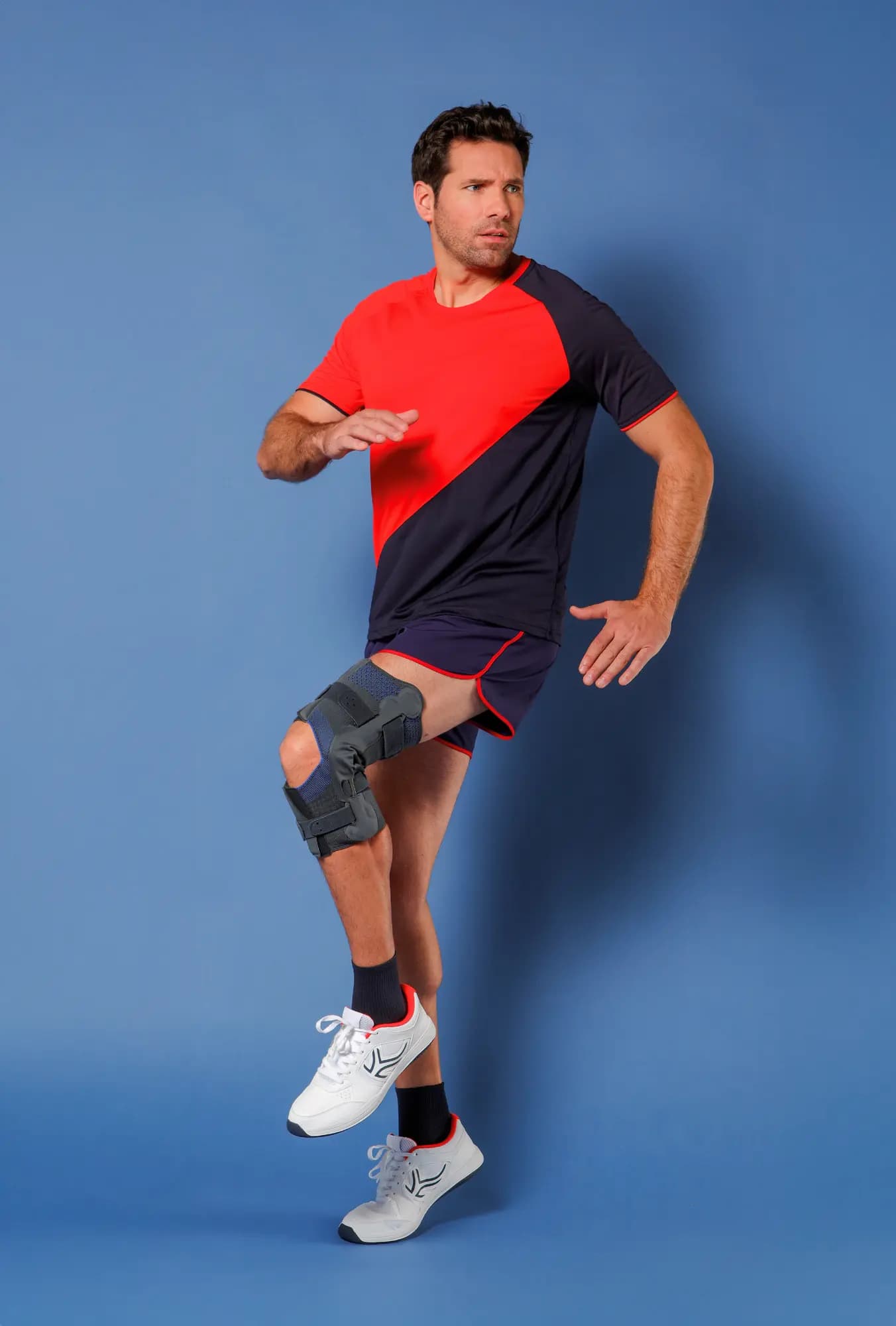Sprain: definition, symptoms and consequences

What is a sprain?
A sprain is trauma to the ligaments, which are the bands of connective tissue that join the bones together(1). It generally occurs when a joint is subjected to sudden or excessive movement beyond its normal capacity(2). Sprains can vary in severity, from mild stretching to complete tearing of the ligaments(1). A sprain can sometimes be accompanied by dislocation of the joint (luxation) or a fracture(2).
What are the different grades of sprain?
Sprains are classified according to the severity of the damage to the ligaments. Here are the differences between a mild, moderate and severe sprain
Mild sprain (Grade 1)
Dans le cas d’une entorse bénigne, il s’agit d’une légère distension des ligaments : les ligaments sont étirés, mais sans déchirure significative.
Moderate sprain (Grade 2)
A moderate sprain is a partial tear of the ligaments: The ligaments are partially torn, resulting in moderate instability of the joint(5).
Severe sprain (Grade 3)
A severe sprain is a complete rupture of the ligaments: the ligaments are completely torn, leading to severe instability of the joint(5).

What are the symptoms of a sprain?
The symptoms of a sprain vary depending on the severity of the injury, but generally include:
Pain: Acute pain may be felt immediately following an injury or may become progressively worse with joint movement or any weight bearing on the injured area(5).
Swelling: An accumulation of fluid in the tissues surrounding the injured joint leads to rapid swelling around the joint(5).
Ecchymosis: Ecchymosis may appear around the injured joint due to the rupture of small blood vessels. These appear in various colours from red to blue, then green and yellow as the injury heals(3).
Reduced mobility: A sprain causes difficulty in moving the injured joint, associated with a feeling of stiffness or locking in the joint(5).
Sensitivity to touch: Sensation of pain or sensitivity when the injured area is pressed(3).
Instability: Sensation that the joint is ‘loose’ or ‘gives’ under weight. In severe cases, the joint may feel unstable and unable to bear weight(5).
What are the possible consequences of a sprain?
If a sprain is not treated properly, it can have a number of short- and long-term consequences:
Chronic pain: Prolonged pain that can persist for weeks, months or even years after the initial injury, affecting daily activities and quality of life. For example, 20-40% of patients with ankle sprains may suffer chronic pain(8 25).
Decreased function: Reduced strength and flexibility in the affected joint leads to increased difficulty in performing previously easy physical movements and activities(8).
Joint instability : A poorly healed sprain can lead to weak ligaments, making the joint more susceptible to further sprains. Permanent joint instability is particularly common in ankle sprains(8).
Post-traumatic arthritis: The joint trauma caused by a sprain can be a risk factor for the subsequent development of arthritis in the injured joint. This could lead to chronic pain and stiffness in the affected joint(9).
What are the different types of sprain?

Ankle and foot sprains
This is the most common form of sprain (3). It generally occurs when the foot is twisted suddenly, which can damage the ligaments around the ankle (2). Sports, falls or even walking on uneven ground can cause an ankle sprain.
More infoMore info
Wrist sprain
Wrist sprains are often caused by a fall onto an outstretched hand. The wrist ligaments may be stretched or torn, causing pain, swelling and difficulty moving the wrist(6).

Knee sprain
Knee sprains are a common injury, particularly among sportspeople(3). They can occur as a result of sudden movements, falls or direct impacts to the knee.

Thumb sprain
This sprain, often referred to as the ‘skier's thumb’, occurs when the thumb is suddenly pulled back, which can tear the ligament at the base of the thumb. It occurs most frequently with sporting activities such as skiing and volleyball(3).

Sprain of the acromioclavicular joint
Sprains of the acromioclavicular joint affect the joint between the clavicle and the acromion (part of the shoulder blade). It occurs mainly during skiing and volleyball(3).
Sprains: are there any predispositions?
Some people are more susceptible to sprains due to a variety of intrinsic and extrinsic factors. These predispositions may be linked to individual characteristics, lifestyle habits or specific conditions. Understanding these risk factors can help in taking preventive measures to reduce the incidence of sprains.
Non-modifiable risk factors
Muscle weakness
Weak muscles provide less support and stability to joints, increasing the risk of sprains. Strong, well-trained muscles help hold joints in place and absorb shock(10).
Previous injuries
People who have already suffered a sprain are more likely to suffer another one. Ligaments can remain weakened after a previous injury, making the joint more vulnerable(11).
Gender
Studies show that women are more likely than men to suffer sprains, particularly of the ankle, due to anatomical and hormonal differences(12).
Lack of flexibility
Less flexible ligaments and tendons are more likely to tear under stress. This underlines the importance of a good warm-up before any physical activity. Good flexibility allows the joints to move more freely and adapt better to sudden or unexpected movements(13).
Anatomical abnormalities
Structural abnormalities, such as uneven leg length or flat feet, can alter the biomechanics of walking and movement, increasing the risk of ligament injury(14).
Coordination problems
People with proprioceptive deficits are more likely to have poor motor coordination, which can lead to imprecise or unbalanced movements, increasing the risk of twisting and ligament damage(15).

Modifiable risk factors
Practice of high-risk sports
Athletes practising sports such as football, volleyball, basketball, rugby or skiing, which involve rapid movements, sudden changes of direction, jumping or physical contact, are particularly vulnerable to sprains because of the stress placed on the joints(14).
Unsuitable footwear
Wearing unsuitable footwear, whether worn, ill-fitting or insufficiently supportive, can increase the risk of sprains, especially to the ankles. Athletes and professionals who walk a lot are particularly at risk(12,16).
Playing or working surfaces
Uneven, slippery or unstable surfaces increase the risk of missteps and twisted joints. Sports played on such surfaces present a higher risk of sprains(17).
Fatigue
Muscle fatigue can reduce the ability of muscles to stabilise joints, increasing the risk of inaccurate movements and injuries. It is important to get adequate rest and avoid over-training(18).
Overweight
Excess weight puts extra pressure on the joints, particularly the ankles and knees, increasing the risk of sprains(19).

FAQ about sprains
Our medical team answers the questions you may have.
Signs that include pain, swelling, bruising and difficulty using the affected joint may point you in this direction. However, a medical diagnosis is still necessary. This may include a physical examination and X-rays(3).
It is generally advisable not to walk on a sprained ankle until the pain subsides. Using crutches or a splint can help you avoid putting weight on the injured ankle(3).
The time it takes for a sprain to heal can vary considerably: from a few weeks for mild sprains to several months for moderate to severe sprains(7).
An X-ray is necessary for an accurate diagnosis(21).
A strain affects the muscles or tendons, while a sprain involves the ligaments. Both conditions can cause pain and swelling, and the initial treatment is often similar(22, 23).
To reduce the risk of sprains, it is essential to :
- Strengthen the muscles around the joints with specific exercises.
- Improve flexibility through regular stretching.
- Wear appropriate, supportivefootwear.
- Warm up properly before any physical activity.
- Practise appropriate sports techniques.
- Avoid dangerous surfaces and maintain a safe environment.
- Managing fatigue with adequate rest periods.
By understanding the predisposition to sprains and taking preventive measures, it is possible to reduce the risk of these injuries and maintain good joint health.
- Melanson SW, Shuman VL. Acute Ankle Sprain. [Updated 2023 May 23]. In: StatPearls [Internet]. Treasure Island (FL): StatPearls Publishing; 2024 Jan-. Available from: https://www.ncbi.nlm.nih.gov/books/NBK459212/
- Mugno AT, Constant D. Recurrent Ankle Sprain. [Updated 2023 Aug 8]. In: StatPearls [Internet]. Treasure Island (FL): StatPearls Publishing; 2024 Jan-. Available from: https://www.ncbi.nlm.nih.gov/books/NBK560619/
- Haute Autorité Santé ,” DISPOSITIFS de COMPRESSION/CONTENTION médicale à usage individuel Utilisation en ORTHOPÉDIE/ RHUMATOLOGIE/ TRAUMATOLOGIE”; Octobre 2012 (consulté le 07/10/2024). HAS : https://www.has-sante.fr/jcms/c_1318289/fr/dispositifs-de-compression/contention-medicale-a-usage-individuel-utilisation-en-orthopedie/rhumatologie/traumatologie.
- Maughan KL, "Ankle Sprain," UpToDate, version 14.3, and Ivins D, "Acute Ankle Sprain: An Update," American Family Physician (Nov. 15, 2006), Vol. 74, No. 10, pp. 1714–20.
- Wolfe MW, Uhl TL, Mattacola CG, McCluskey LC. Management of ankle sprains. Am Fam Physician. 2001 Jan 1;63(1):93-104. Erratum in: Am Fam Physician 2001 Aug 1;64(3):386. PMID: 11195774.
- May Jr DD, Varacallo M. Wrist Sprain. [Updated 2023 Aug 4]. In: StatPearls [Internet]. Treasure Island (FL): StatPearls Publishing; 2024 Jan-. Available from: https://www.ncbi.nlm.nih.gov/books/NBK551514/
- InformedHealth.org [Internet]. Cologne, Germany: Institute for Quality and Efficiency in Health Care (IQWiG); 2006-. In brief: How does the knee work? [Updated 2024 Mar 8]. Available from: https://www.ncbi.nlm.nih.gov/books/NBK561512/
- Vuurberg G, Hoorntje A, Wink LM, et alDiagnosis, treatment and prevention of ankle sprains: update of an evidence-based clinical guidelineBritish Journal of Sports Medicine 2018;52:956. https://doi.org/10.1136/bjsports-2017-098106
- Delco ML, Kennedy JG, Bonassar LJ, Fortier LA. Post-traumatic osteoarthritis of the ankle: A distinct clinical entity requiring new research approaches. J Orthop Res. 2017 Mar;35(3):440-453. doi: 10.1002/jor.23462. Epub 2016 Nov 8. PMID: 27764893; PMCID: PMC5467729.
- Baumhauer JF, Alosa DM, Renström PAFH, Trevino S, Beynnon B. A Prospective Study of Ankle Injury Risk Factors. The American Journal of Sports Medicine. 1995;23(5):564-570. doi:10.1177/036354659502300508
- Pourgharib Shahi MH, Selk Ghaffari M, Mansournia MA, Halabchi F. Risk Factors Influencing the Incidence of Ankle Sprain Among Elite Football and Basketball Players: A Prospective Study. Foot Ankle Spec. 2021 Dec;14(6):482-488. doi: 10.1177/1938640020921251. Epub 2020 May 28. PMID: 32463306.
- Beynnon BD, Murphy DF, Alosa DM. Predictive Factors for Lateral Ankle Sprains: A Literature Review. J Athl Train. 2002 Dec;37(4):376-380. PMID: 12937558; PMCID: PMC164368.
- McKay GD, Goldie PA, Payne WR, Oakes BW. Ankle injuries in basketball: injury rate and risk factors. Br J Sports Med. 2001 Apr;35(2):103-8. doi: 10.1136/bjsm.35.2.103. PMID: 11273971; PMCID: PMC1724316.
- Raj MA, Tafti D, Kiel J. Pes Planus. [Updated 2023 May 23]. In: StatPearls [Internet]. Treasure Island (FL): StatPearls Publishing; 2024 Jan-. Available from: https://www.ncbi.nlm.nih.gov/books/NBK430802/
- Xue X, Ma T, Li Q, Song Y, Hua Y. Chronic ankle instability is associated with proprioception deficits: A systematic review and meta-analysis. J Sport Health Sci. 2021 Mar;10(2):182-191. doi: 10.1016/j.jshs.2020.09.014. Epub 2020 Oct 2. PMID: 33017672; PMCID: PMC7987558.
- Jessica A. Dobson, Diane L. Riddiford-Harland, Alison F. Bell, Julie R. Steele, Work boot design affects the way workers walk: A systematic review of the literature, Applied Ergonomics, Volume 61, 2017, Pages 53-68, ISSN 0003-6870, https://doi.org/10.1016/j.apergo.2017.01.003.
- B. J. McCriskin, K. L. Cameron, J. D. Orr, and B. R. Waterman, “Management and prevention of acute and chronic lateral ankle instability in athletic patient populations,” World J. Orthop., vol. 6, no. 2, pp. 161–171, 2015, doi: 10.5312/wjo.v6.i2.161
- Mohammadi F, Roozdar A. Effects of Fatigue Due to Contraction of Evertor Muscles on the Ankle Joint Position Sense in Male Soccer Players. The American Journal of Sports Medicine. 2010;38(4):824-828. doi:10.1177/0363546509354056
- Fousekis K, Tsepis E, Vagenas G. Intrinsic risk factors of noncontact ankle sprains in soccer: a prospective study on 100 professional players. Am J Sports Med. 2012 Aug;40(8):1842-50. doi: 10.1177/0363546512449602. Epub 2012 Jun 14. PMID: 22700889.
- Van den Bekerom MP, Struijs PA, Blankevoort L, Welling L, van Dijk CN, Kerkhoffs GM. What is the evidence for rest, ice, compression, and elevation therapy in the treatment of ankle sprains in adults? J Athl Train. 2012 Jul-Aug;47(4):435-43. doi: 10.4085/1062-6050-47.4.14. PMID: 22889660; PMCID: PMC3396304.
- Pinto A, Berritto D, Russo A, Riccitiello F, Caruso M, Belfiore MP, Papapietro VR, Carotti M, Pinto F, Giovagnoni A, Romano L, Grassi R. Traumatic fractures in adults: missed diagnosis on plain radiographs in the Emergency Department. Acta Biomed. 2018 Jan 19;89(1-S):111-123. doi: 10.23750/abm.v89i1-S.7015. PMID: 29350641; PMCID: PMC6179080.
- Brumitt J, Cuddeford T. CURRENT CONCEPTS OF MUSCLE AND TENDON ADAPTATION TO STRENGTH AND CONDITIONING. Int J Sports Phys Ther. 2015 Nov;10(6):748-59. PMID: 26618057; PMCID: PMC4637912.
- Riley Brassington1, Miguel Caldeira2, Nével Neveling2, Lucille Smith3,
Billy Mason1,4, Stuart Semple1, Andrew J. McKune “THE EFFICACY OF RICE THERAPY IN TREATING EXERCISE-INDUCED MUSCLE DAMAGE.”, Journal of Australian Strength & Conditioning. 31(03):4-12. 2023 © ASCA - Cope, J., & Samchukov, M. (2009). Regenerate bone formation and remodeling during mandibular osteodistraction.. The Angle orthodontist, 70 2, 99-111 . 2.0.CO;2" target="_blank">https://doi.org/10.1043/0003-3219(2000)070<0099:RBFARD>2.0.CO;2.
- , R. (1994). Persistently Painful Sprained Ankle.. The Journal of the American Academy of Orthopaedic Surgeons, 2 5, 270-280.


